|
Honda Accord (Europe /
Japan) / Acura TSX
Debut: 2008
Maker: Honda
Predecessor: Accord Mk7
|
|
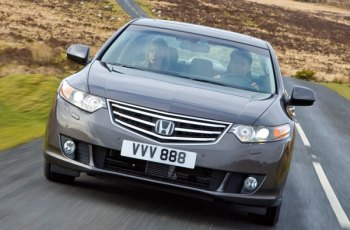
|
European Accord aims at premium cars,
unlike American Accord.
|
Since
the late 1990s Honda
has been producing two different Accords - a larger Accord for North
America market and a smaller one for Japan and Europe. Although they
share some vital components, such as suspensions, steering,
electronics, gearbox and some engines, their similarities are no more
than, say, a Volkswagen Passat relates to Golf. The American Accord is
seen as a big car that most American families ask for. In contrast, the
European Accord is more elegant, agile, efficient and seen as a
contender in the league of BMW 3-Series and Audi A4 rather than
mainstream family cars... at least in the viewpoint of Honda. As a
result, Honda sells it in the USA as Acura TSX to take advantage of its
premium image.
Nevertheless, until now few people are convinced that the Accord or
Acura TSX is a match for German premium cars. No matter driving
dynamics or packaging, it is still closer to mainstream family cars
than premium cars. To raise the game, this time Honda did a lot of
improvement to the new car...
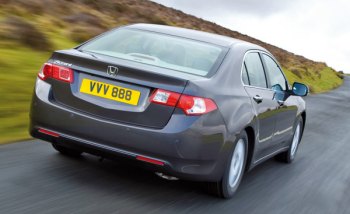
|
Styling is more elegant than its
American sister
|
First of all you will notice that it
is considerably larger
than before - 60 mm longer overall, 35 mm longer in wheelbase and 80 mm
wider. The emphasis here is not interior space - as head and legroom
are virtually unchanged, only shoulder room is significantly increased
- but to provide better handling. The much wider tracks and 5 mm
reduction of height enhance cornering stability. A stiffer chassis also
helps. Torsional rigidity has been increased by 15 percent thanks to
the use of more high-strength steel and structural reinforcement. The
retuned double-wishbone / multi-link suspension has improved geometry
and new mechanical adaptive dampers.
Not so great news is the use of electrical power steering instead of
hydraulic one. Although it is claimed to be developed from the one used
in NSX, and it works better than most electric systems on the market,
it still fails to match a hydraulic or electro-hydraulic steering for
communicatiing with the front tires. Nevertheless, it incorporates a
new function called "Motion Adaptive". When the car senses instability,
say, excessive oversteer under braking, its electric motor exerts a
torque to the steering to assist correcting the oversteer. As the
assistant torque acts as a supportive role, it will not override the
driver control like BMW's Active Steer.
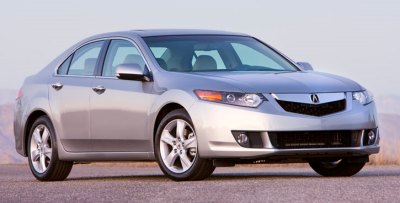
|
Acura TSX differs mainly in the design
of front grille
|
On the road, the new Accord has both
ride and handling
improved over its predecessor. Its ride quality is especially superb,
smoothing out the irregularities that would have unsettled Audi A4. The
wide tracks result in flat cornering. Steering agility is also pretty
good. However, to say the Accord matching BMW 3-Series in dynamics is
overstated - its front-wheel drive chassis will never allow that. Even
in the front-drive field it still lags behind Mazda 6 and Ford Mondeo,
because the Honda trades some sporty handling with ride comfort. The
numb steering is also a reason.
The new European Accord is about 70 kilograms heavier than the car it
replaced. This extra weight offsets the slight power gain of its three
engines and results in unchanged performance, sadly. Base engine is
still the 156-horsepower 2.0-liter DOHC i-VTEC (though now complies
with Euro 5 emission standard). The 2.4-liter DOHC i-VTEC with
twin-balancer shafts gains 10 horsepower thanks to higher compression
(from 10.5:1 to 11.0:1), lighter intake valves, revised cam timing and
smoother exhaust. Still, 201 horsepower and 172 lb-ft of torque is not
enough for a compact premium car these days. A Ford Mondeo 2.5ST runs a
turbocharged five-cylinder engine good for 220 hp and 236 lb-ft.
Comparatively, the Honda's short of low-down torque makes it feel
slower than its 0-60 mph figure (est 7.5 seconds) suggested. On the
positive side, the Honda engine is smooth and free-revving, and the
light-clutch / slick gearchange of the 6-speed manual / seamless shift
of the 5-speed automatic are as good as you would expect for a Honda.
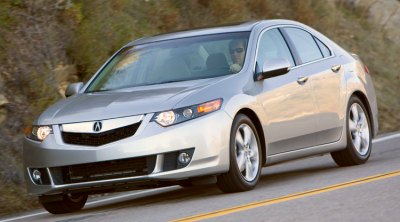
|
To say the Accord matching BMW
3-Series in dynamics is overstated...
|
The final engine is the 2.2 i-DTEC
(what a misleading name
as it has no relationship with VTEC) turbocharged diesel engine. Now it
features piezo multi-injection and Honda's innovative exhaust cleaning
technology to comply with the most stringent US Tier II Bin 5 emission
standard without resorting to urea addictive like Mercedes' Bluetec. It
produces 150 horsepower and 258 lb-ft of torque, 10 hp and 7 lb-ft more
than before. Nevertheless, it is not the best diesel engine in the
class. The German has some engines producing more power from less
capacity yet being more frugal. Besides, the Honda diesel engine
produces more vibration at low rpm. Japanese still trails European in
diesel technology.
The Japanese car also trails German for design and packaging. Although
the European Accord looks more stylish and elegant than its American
sister, it does not stand out from the mainstream crowd and the rest of
Honda's lineup. Inside, the cabin employs generally high-quality
materials, but the design is busy and the overcrowded center console is
a nightmare for ergonomics. Rear seat space could be a disappointment
beside Ford Mondeo, as it won't accommodate people over 6 feet tall.
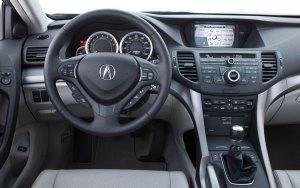
|
The overcrowded center console is a
nightmare for ergonomics
|
The European Accord is not a bad car,
far from it. The
problem is, in our eyes it has no areas particularly outstanding. To a
premium car this is a serious problem. Without a strong image, a
premium price tag won't be easily acceptable. |
| The
above report was last updated on 13 Apr
2008. All Rights Reserved. |
|
Acura TSX V6
|
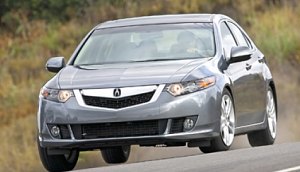 Acura
TSX, or the European Honda Accord, is a likable car. It is a
well-rounded package, offering good handling, ride, build quality and
style. At the same time, its slick-shifting 6-speed manual gearbox and
high-revving VTEC four-pot engine give it an unusual character.
However, people in the United States always call for more power and
torque. Honda America also thinks the Acura needs a V6 engine to
justify its premium market positioning and compete with the likes of
Infiniti, Lexus, Audi and BMW. In mid-2009, they introduced the V6 TSX. Acura
TSX, or the European Honda Accord, is a likable car. It is a
well-rounded package, offering good handling, ride, build quality and
style. At the same time, its slick-shifting 6-speed manual gearbox and
high-revving VTEC four-pot engine give it an unusual character.
However, people in the United States always call for more power and
torque. Honda America also thinks the Acura needs a V6 engine to
justify its premium market positioning and compete with the likes of
Infiniti, Lexus, Audi and BMW. In mid-2009, they introduced the V6 TSX.
This 3.5-liter SOHC V6 comes straight from Acura TL. It is not exactly
the latest technology - no direct injection or continuous variable cam
phasing, for example. Power boosting technology is limited to the well
proven cam-lobe-changing VTEC mechanism. The 5-speed automatic gearbox
is also far from new. Nevertheless, you can't complain for lack of
firepower, because this combo delivers 280 horsepower and 254
pound-foot of torque, powerful enough to register 6 seconds flat in
0-60 mph sprint and induce some torque steer if you push it in corner
without mercy. The transmission, however, is a tad slow, and its
throttle blip on downshift is not quite enough to match rev. This make
the powertrain less satisfying than it looks on paper.
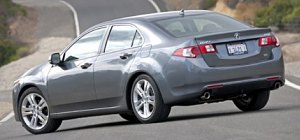 Predictably,
the V6 and auto tranny puts an additional 120 kg to the TSX, and the
majority is located at the wrong side. To compensate, the front
suspensions get stiffer springs and retuned dampers. Brakes are
marginally uprated to cope with the extra weight. The wheels are
enlarged to 18-inch items, shod with 235/45 tires instead of the
regular 225/50. Otherwise, the TSX is mostly unchanged. Predictably,
the V6 and auto tranny puts an additional 120 kg to the TSX, and the
majority is located at the wrong side. To compensate, the front
suspensions get stiffer springs and retuned dampers. Brakes are
marginally uprated to cope with the extra weight. The wheels are
enlarged to 18-inch items, shod with 235/45 tires instead of the
regular 225/50. Otherwise, the TSX is mostly unchanged.
On the road, the heftier nose does take some edge away from the TSX's
handling. It hasn't ruin the handling, but you can feel the car steers
with less eagerness. Torque steer is not an issue unless you pretend to
be Sebastien Loeb. However, the front-drive Acura never feels as agile
or adjustable as the rear-drive BMW or Infiniti. Keep it light and less
powerful, its disadvantage is not that obvious. Pump it to 280 horses
and burden its nose with a V6, it can no longer hide its Accord basis.
Therefore our recommendation is still the 2.4 engine with manual
gearbox.
|
| The
above report was last updated on 30 May 2010. All Rights Reserved. |
|
|
|
General remarks
|
Accord 2.0
|
Accord 2.4 / Acura TSX
|
Accord 2.2 i-DTEC
|
Layout
|
Front-engined, FWD
|
Front-engined, FWD
|
Front-engined, FWD |
Chassis
|
Steel monocoque
|
Steel monocoque |
Steel monocoque |
Body
|
Mainly steel
|
Mainly steel |
Mainly steel |
| Length / width / height |
4725 / 1840
/ 1440 mm |
4725 / 1840
/ 1440 mm |
4725 / 1840
/ 1440 mm
|
| Wheelbase |
2705 mm |
2705 mm |
2705 mm
|
Engine
|
Inline-4
|
Inline-4 |
Inline-4, diesel
|
Capacity
|
1997 cc
|
2354 cc |
2199 cc
|
Valve gears
|
SOHC 16 valves, VVT
|
DOHC 16 valves, VVT |
DOHC 16 valves
|
Induction
|
VIM
|
- |
VTG turbo
|
Other engine features
|
-
|
-
|
CDI
|
Max power
|
156 hp / 6300 rpm
|
201 hp / 7000 rpm
|
150 hp / 4000 rpm
|
Max torque
|
142 lbft / 4100 rpm
|
172 lbft / 4500 rpm
|
258 lbft / 2000 rpm
|
Transmission
|
6-speed manual
|
6-speed manual |
6-speed manual |
Suspension layout
|
F: double-wishbone
R: multi-link
|
F: double-wishbone
R: multi-link |
F: double-wishbone
R: multi-link |
Suspension features
|
-
|
- |
- |
Tyres front/rear
|
205/60R16
|
225/50R17
|
215/60R16
|
Kerb weight
|
1412 kg
|
1484 kg (US: 1540kg)
|
1540 kg
|
Top speed
|
134 mph (c)
|
141 mph (c)
|
132 mph (c)
|
0-60 mph (sec)
|
8.7 (c)
|
6.7*
|
8.8 (c)
|
0-100 mph (sec)
|
-
|
18.0*
|
-
|
| Performance
tested by: |
*C&D |
|
Acura TSX V6
|
|
|
Layout
|
Front-engined, FWD
|
|
|
Chassis
|
Steel monocoque
|
|
|
Body
|
Mainly steel
|
|
|
| Length / width / height |
4725 / 1840
/ 1440 mm |
|
|
| Wheelbase |
2705 mm |
|
|
Engine
|
V6, 60-degree
|
|
|
Capacity
|
3471 cc
|
|
|
Valve gears
|
SOHC 24 valves, VVT+L (VTEC) |
|
|
Induction
|
-
|
|
|
Other engine features
|
-
|
|
|
Max power
|
280 hp / 6200 rpm
|
|
|
Max torque
|
254 lbft / 5000 rpm
|
|
|
Transmission
|
5-speed automatic
|
|
|
Suspension layout
|
F: double-wishbone
R: multi-link
|
|
|
Suspension features
|
-
|
|
|
Tyres front/rear
|
235/45WR18
|
|
|
Kerb weight
|
1660 kg
|
|
|
Top speed
|
-
|
|
|
0-60 mph (sec)
|
6.1* / 5.9** / 6.0***
|
|
|
0-100 mph (sec)
|
15.6* / 14.6** / 15.1***
|
|
|
| Performance
tested by: |
*C&D, **R&T, ***MT
|
|
|